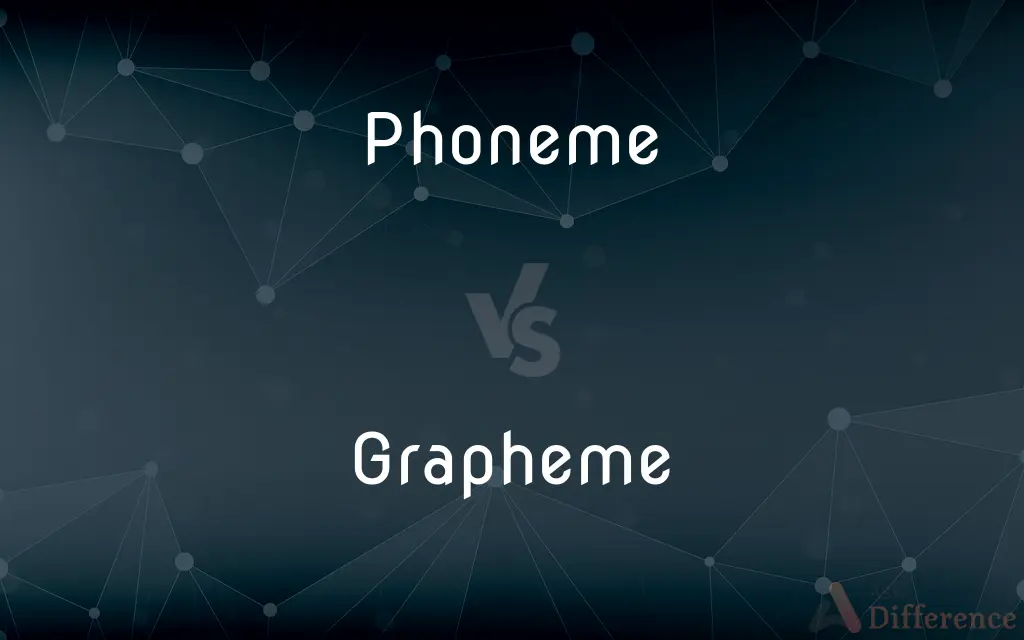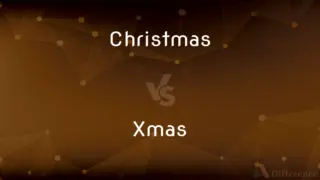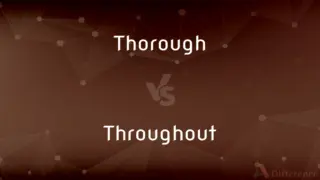Phoneme vs. Grapheme — What's the Difference?
By Tayyaba Rehman — Updated on October 16, 2023
A phoneme is the smallest unit of sound in speech, while a grapheme is the smallest written unit representing a phoneme.

Difference Between Phoneme and Grapheme
Table of Contents
ADVERTISEMENT
Key Differences
A phoneme pertains to the domain of sound. It is the smallest distinguishable unit of sound that can differentiate meanings in a language. For instance, the phonemes /p/ and /b/ differentiate "pat" from "bat." On the other hand, a grapheme concerns written representation. It's the smallest unit in written language that corresponds to a phoneme. In the word "bat," the grapheme "b" represents the phoneme /b/.
While phonemes are essential for spoken language, they don't have a fixed visual form. They are abstract and can be represented by different graphemes. For instance, the phoneme /k/ can be represented by various graphemes such as "c," "k," and "ck." Conversely, graphemes have a fixed appearance in written form. A grapheme like "c" will consistently appear the same in writing, but its phonemic sound might change, as in "cat" and "cent."
Understanding phonemes is crucial in areas like phonology and linguistics, as they delve into the sounds of languages and how they convey meaning. Graphemes, however, are vital for orthography, the conventional writing system of a language. They help in documenting language, ensuring consistent representation of phonemes.
Phonemes and graphemes play distinct roles in language learning. While phonemic awareness, understanding and hearing the sounds of speech, is foundational for early readers, graphemic knowledge helps in reading and writing. A child might recognize the phoneme /s/ and associate it with the grapheme "s" in "sun."
Lastly, while both phonemes and graphemes are foundational in understanding language, their interplay is especially evident in alphabetic languages. In such languages, graphemes (letters or groups of letters) are systematically linked to phonemes, enabling efficient reading and writing.
ADVERTISEMENT
Comparison Chart
Definition
Smallest sound unit in speech.
Smallest written unit representing a phoneme.
Pertains to
Sound of language.
Written representation of language.
Role in language
Differentiates meaning through sound variation.
Represents phonemes in writing.
Importance in
Phonology and linguistics.
Orthography and writing systems.
Example
The phonemes /p/ and /b/ differentiate "pat" from "bat."
The grapheme "b" represents the phoneme /b/ in "bat."
Compare with Definitions
Phoneme
Abstract and can be represented by multiple graphemes.
The phoneme /k/ can be represented by c, k, or ck.
Grapheme
The smallest written unit representing a phoneme.
In the word chat, the grapheme ch represents a single phoneme.
Phoneme
Differentiates meaning in languages.
The phoneme /t/ in tap gives it a distinct sound from cap.
Grapheme
Important in the orthography of a language.
The consistent use of graphemes ensures a standardized writing system.
Phoneme
Central in phonology and linguistics.
Phonologists study phonemes to understand sound patterns in languages.
Grapheme
Has a fixed appearance in written form.
The grapheme a will always look the same, but its sound may vary.
Phoneme
Important for phonemic awareness in early reading.
Recognizing the phoneme /m/ is crucial for reading the word mat.
Grapheme
Helps in documenting language.
Graphemes ensure that the written form of words matches their spoken form.
Phoneme
The smallest sound unit in speech.
The change of one phoneme can alter the meaning of a word.
Grapheme
Systematically linked to phonemes in alphabetic languages.
Each grapheme in the alphabet corresponds to one or more phonemes.
Phoneme
In phonology and linguistics, a phoneme is a unit of sound that can distinguish one word from another in a particular language. For example, in most dialects of English, with the notable exception of the West Midlands and the north-west of England, the sound patterns (sin) and (sing) are two separate words that are distinguished by the substitution of one phoneme, /n/, for another phoneme, /ŋ/.
Grapheme
In linguistics, a grapheme is the smallest functional unit of a writing system.There are two main opposing grapheme concepts. In the so-called referential conception, graphemes are interpreted as the smallest units of writing that correspond with sounds (more accurately phonemes).
Phoneme
Any of the perceptually distinct units of sound in a specified language that distinguish one word from another, for example p, b, d, and t in the English words pad, pat, bad, and bat.
Grapheme
A letter of an alphabet.
Phoneme
The smallest phonetic unit in a language that is capable of conveying a distinction in meaning, as the m of mat and the b of bat in English.
Grapheme
All of the letters and letter combinations that represent a phoneme, as f, ph, and gh for the phoneme /f/.
Phoneme
An indivisible unit of sound in a given language. A phoneme is an abstraction of the physical speech sounds (phones) and may encompass several different phones.
Grapheme
A fundamental unit of a writing system, corresponding to (for example) letters in the English alphabet or jamo in Korean Hangeul.
Phoneme
(linguistics) one of a small set of speech sounds that are distinguished by the speakers of a particular language
Grapheme
In alphabetic writing, the shortest group of letters composing a phoneme.
Grapheme
A written symbol that is used to represent speech.
Grapheme
A written symbol that is used to represent speech;
The Greek alphabet has 24 characters
Common Curiosities
What is a phoneme?
A phoneme is the smallest unit of sound in speech that can differentiate meaning.
Do all graphemes represent sounds?
Most graphemes represent sounds, but some, like silent letters, don't have a pronounced phoneme.
Are phonemes always represented by single letters?
No, phonemes can be represented by single letters, digraphs (two letters), or even trigraphs (three letters).
How is a grapheme different from a letter?
A grapheme may consist of one or more letters representing a single phoneme.
Are graphemes consistent across languages?
No, graphemes vary based on the writing system and language.
How many phonemes are there in English?
English has around 44 phonemes, though the number can vary slightly based on dialects.
Can one grapheme represent multiple phonemes?
Rarely, but in most cases, a grapheme represents a single phoneme.
How do phonemes and graphemes assist in reading?
Phonemes help in sounding out words, while graphemes provide the visual representation of those sounds.
Can a single phoneme be represented by different graphemes?
Yes, for instance, the phoneme /k/ can be represented by "c," "k," or "ck."
Why is phonemic awareness important in education?
Phonemic awareness helps children recognize and manipulate phonemes, essential for reading and spelling.
How are phonemes and graphemes related?
Phonemes are sounds, and graphemes are their written representations in a language.
What's the role of phonemes in linguistics?
Phonemes help linguists understand sound patterns and variations in languages.
Can the relationship between phonemes and graphemes be complex?
Yes, especially in languages with irregular spelling patterns, where a phoneme might be represented by various graphemes.
Are graphemes language-specific?
Yes, graphemes vary based on the writing system and conventions of a specific language.
Is a grapheme the same as a glyph?
No, a glyph is a specific shape of a letter or character, whereas a grapheme represents a phoneme.
Share Your Discovery

Previous Comparison
Christmas vs. Xmas
Next Comparison
Thorough vs. ThroughoutAuthor Spotlight
Written by
Tayyaba RehmanTayyaba Rehman is a distinguished writer, currently serving as a primary contributor to askdifference.com. As a researcher in semantics and etymology, Tayyaba's passion for the complexity of languages and their distinctions has found a perfect home on the platform. Tayyaba delves into the intricacies of language, distinguishing between commonly confused words and phrases, thereby providing clarity for readers worldwide.














































